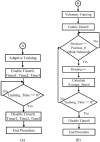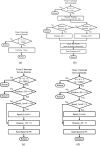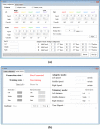Effect of stress on the rehabilitation performance of rats with repetitive mild fluid percussion-induced traumatic brain injuries
- PMID: 38406191
- PMCID: PMC10881937
- DOI: 10.1007/s11571-023-09961-z
Effect of stress on the rehabilitation performance of rats with repetitive mild fluid percussion-induced traumatic brain injuries
Abstract
Animal models of traumatic brain injury (TBI) have shown that impaired motor and cognitive function can be improved by physical exercise. However, not each animal with TBI can be well rehabilitated at the same training intensity due to a high inter-subject variability. Hence, this paper presents a two-stage wheel-based mixed-mode rehabilitation mechanism by which the effect of stress on the rehabilitation performance was investigated. The mixed-mode rehabilitation mechanism consists of a two-week adaptive and a one-week voluntary rehabilitation program as Stages 1 and 2, respectively. In Stage 1, the common over and undertraining problem were completely resolved due to the adaptive design, and rats ran voluntarily over a 30-min duration in Stage 2. The training intensity adapted to the physical condition of all the TBI rats at all times in Stage 1, and then the self-motivated running rats were further rehabilitated under the lowest level of stress in Stage 2. For comparison purposes, another group of rats took a 3-week adaptive rehabilitation program. During the 3-week program, the rehabilitation performance of the rats were assessed using modified neurologic severity score (mNSS) and an 8-arm radial maze. Surprisingly, the group taking the mixed mode program turned out to outperform its counterpart in terms of mNSS. The mixed-mode rehabilitation mechanism was validated as an effective and efficient way to help rats restore motor, neurological and cognitive function after TBI. It was validated that the rehabilitation performance can be optimized under the lowest level of stress.
Keywords: Cognitive function; Exercise; Modified neurologic severity score; Neurologic status; Rehabilitation; Repetitive mild fluid percussion-induced traumatic brain injury; Short-term memory errors; Stress.
© The Author(s), under exclusive licence to Springer Nature B.V. 2023. Springer Nature or its licensor (e.g. a society or other partner) holds exclusive rights to this article under a publishing agreement with the author(s) or other rightsholder(s); author self-archiving of the accepted manuscript version of this article is solely governed by the terms of such publishing agreement and applicable law.
Conflict of interest statement
Conflict of interestThe authors declare no conflicts of interest.
Figures













Similar articles
-
Exercise Rehabilitation Attenuates Cognitive Deficits in Rats with Traumatic Brain Injury by Stimulating the Cerebral HSP20/BDNF/TrkB Signalling Axis.Mol Neurobiol. 2018 Nov;55(11):8602-8611. doi: 10.1007/s12035-018-1011-2. Epub 2018 Mar 25. Mol Neurobiol. 2018. PMID: 29574629
-
The Effect of Riboflavin on Neurological Rehabilitation after Traumatic Brain Injury in Children.Discov Med. 2024 Aug;36(187):1588-1599. doi: 10.24976/Discov.Med.202436187.145. Discov Med. 2024. PMID: 39190374
-
Behavioral deficits after mild traumatic brain injury by fluid percussion in rats.Neurosci Lett. 2024 Jan 1;818:137550. doi: 10.1016/j.neulet.2023.137550. Epub 2023 Nov 4. Neurosci Lett. 2024. PMID: 37926292
-
The interplay between neuropathology and activity based rehabilitation after traumatic brain injury.Brain Res. 2016 Jun 1;1640(Pt A):152-163. doi: 10.1016/j.brainres.2016.01.016. Epub 2016 Jan 14. Brain Res. 2016. PMID: 26776479 Review.
-
Rehabilitation for Impaired Attention in the Acute and Post-Acute Phase After Traumatic Brain Injury: A Narrative Review.Korean J Neurotrauma. 2022 Nov 21;19(1):20-31. doi: 10.13004/kjnt.2023.19.e1. eCollection 2023 Mar. Korean J Neurotrauma. 2022. PMID: 37051033 Free PMC article. Review.
References
-
- Amoros-Aguilar L, Portell-Cortes I, Costa-Miserachs D, Torras-Garcia M, Riubugent-Camps E, Almolda B, Coll-Andreu M. The benefits of voluntary physical exercise after traumatic brain injury on rat's object recognition memory: a comparison of different temporal schedules. Exp Neurol. 2020 doi: 10.1016/j.expneurol.2020.113178. - DOI - PubMed
-
- Baddeley AD, Hitch GJ. Developments in the concept of working memory. Neuropsychology. 1994;8(4):485–493. doi: 10.1037/0894-4105.8.4.485. - DOI
LinkOut - more resources
Full Text Sources
Miscellaneous

